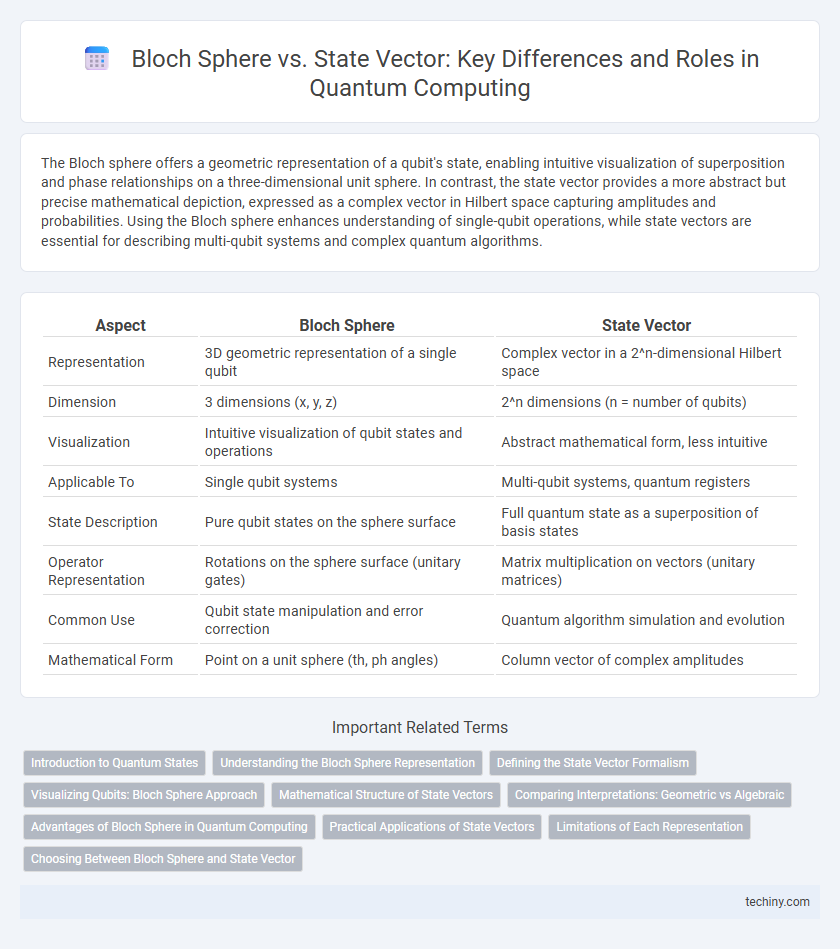The Bloch sphere offers a geometric representation of a qubit's state, enabling intuitive visualization of superposition and phase relationships on a three-dimensional unit sphere. In contrast, the state vector provides a more abstract but precise mathematical depiction, expressed as a complex vector in Hilbert space capturing amplitudes and probabilities. Using the Bloch sphere enhances understanding of single-qubit operations, while state vectors are essential for describing multi-qubit systems and complex quantum algorithms.
Table of Comparison
| Aspect | Bloch Sphere | State Vector |
|---|---|---|
| Representation | 3D geometric representation of a single qubit | Complex vector in a 2^n-dimensional Hilbert space |
| Dimension | 3 dimensions (x, y, z) | 2^n dimensions (n = number of qubits) |
| Visualization | Intuitive visualization of qubit states and operations | Abstract mathematical form, less intuitive |
| Applicable To | Single qubit systems | Multi-qubit systems, quantum registers |
| State Description | Pure qubit states on the sphere surface | Full quantum state as a superposition of basis states |
| Operator Representation | Rotations on the sphere surface (unitary gates) | Matrix multiplication on vectors (unitary matrices) |
| Common Use | Qubit state manipulation and error correction | Quantum algorithm simulation and evolution |
| Mathematical Form | Point on a unit sphere (th, ph angles) | Column vector of complex amplitudes |
Introduction to Quantum States
Quantum states can be represented using either the Bloch sphere or state vectors, each offering unique advantages for visualization and computation. The Bloch sphere provides a geometric representation of a single qubit's state as a point on a unit sphere, simplifying the understanding of superposition and quantum gates. State vectors use complex amplitudes in a Hilbert space basis, capturing the full quantum information and enabling calculations in multi-qubit systems.
Understanding the Bloch Sphere Representation
The Bloch sphere provides a geometric representation of a qubit's pure state, visualizing superposition as a point on the sphere's surface with coordinates defined by polar and azimuthal angles. In contrast, the state vector represents the qubit in a complex Hilbert space using amplitude coefficients that describe probabilities for basis states |0> and |1> . Understanding the Bloch sphere simplifies analysis of single-qubit gates and quantum state transformations by illustrating rotations and phase shifts as movements on the sphere.
Defining the State Vector Formalism
The state vector formalism represents qubit states as complex linear combinations of basis states |0> and |1> in a two-dimensional Hilbert space, capturing both amplitude and phase information essential for quantum computation. Unlike the Bloch sphere, which provides a geometric visualization of a qubit as a point on a unit sphere, the state vector enables precise mathematical manipulation of quantum states using vector spaces and linear algebra. This formalism is fundamental for describing quantum gates, entanglement, and superposition within quantum algorithms and error correction protocols.
Visualizing Qubits: Bloch Sphere Approach
The Bloch sphere represents a qubit as a point on the surface of a unit sphere, providing an intuitive geometric visualization of quantum states unlike the abstract complex amplitudes in a state vector. This approach highlights the qubit's superposition and phase through spherical coordinates, enhancing understanding of quantum operations and coherence. It is especially useful in illustrating single-qubit gates and quantum state evolution in quantum computing research and education.
Mathematical Structure of State Vectors
State vectors in quantum computing are represented as complex vectors in a Hilbert space, typically \(\mathbb{C}^2\) for a single qubit, capturing both amplitude and phase information of quantum states. The Bloch sphere provides a geometric representation by mapping these state vectors onto points on a unit sphere, illustrating qubit states through spherical coordinates \((\theta, \phi)\) related to the vector's components. This geometric model simplifies visualization and manipulation of qubit states, while the underlying mathematical structure remains grounded in linear algebra and complex vector spaces.
Comparing Interpretations: Geometric vs Algebraic
The Bloch sphere provides a geometric interpretation of qubit states as points on a unit sphere, offering intuitive visualization of quantum superposition and coherence. In contrast, the state vector represents qubit states algebraically in a complex Hilbert space, emphasizing linear algebraic manipulations and amplitude calculations. Comparing these interpretations highlights the Bloch sphere's strength in conceptual clarity and the state vector's advantage in precise mathematical operations for quantum algorithms.
Advantages of Bloch Sphere in Quantum Computing
The Bloch sphere offers a powerful geometric visualization of qubit states, enabling intuitive understanding of quantum superposition and coherence. By representing qubit states as points on the surface of a sphere, it simplifies the analysis of single-qubit operations and quantum gate transformations. This visualization aids in error correction, algorithm design, and enhances clarity in communicating quantum computing concepts compared to abstract state vectors.
Practical Applications of State Vectors
State vectors provide a more straightforward and scalable representation for describing qubit states in quantum computing algorithms, enabling efficient manipulation of multi-qubit systems. Unlike the Bloch sphere, which visualizes only single-qubit pure states, state vectors accommodate mixed states and entangled qubits essential for practical quantum error correction and quantum gate design. This makes state vectors indispensable for simulating complex quantum circuits and optimizing quantum algorithms in real-world applications.
Limitations of Each Representation
The Bloch sphere offers an intuitive geometric visualization for single qubit states but struggles to represent multi-qubit or entangled states due to its three-dimensional constraint. State vectors provide a complete and scalable mathematical description of quantum systems, yet they become exponentially complex and less interpretable as the number of qubits increases. Both representations highlight trade-offs between visualization simplicity and computational scalability in quantum computing.
Choosing Between Bloch Sphere and State Vector
Choosing between the Bloch sphere and state vector representations depends on the complexity and dimensionality of the quantum system under study. The Bloch sphere provides an intuitive geometric visualization for single-qubit states, making it ideal for understanding qubit dynamics and quantum gate operations. In contrast, state vectors offer a more general and scalable mathematical framework suitable for multi-qubit systems and formal quantum algorithm analysis.
Bloch sphere vs State vector Infographic

 techiny.com
techiny.com